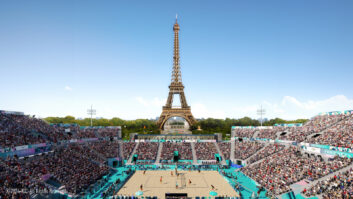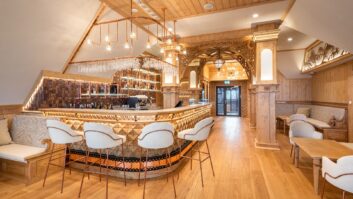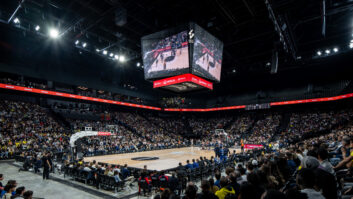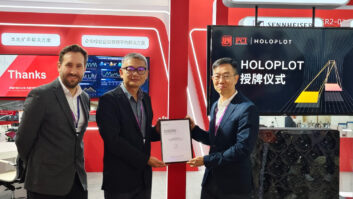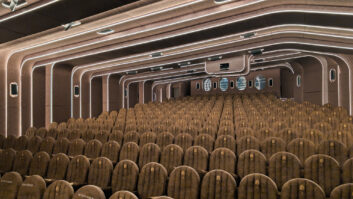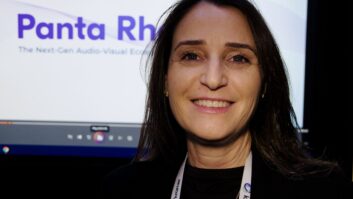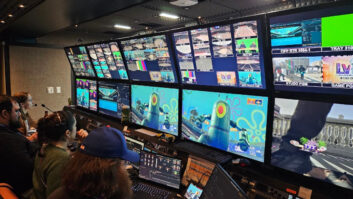When it comes to audio products and systems at the key Olympic venues, there is no doubt that the Harman Pro Group has a genuinely formidable presence. Indeed, it has supplied comprehensive AV systems to no fewer than 12 venues – encompassing everything from the Fengtai Softball Field to the Laoshan Velodrome.
There is insufficient space here to detail all of the Harman systems in use (in truth, that would require a separate multi-page article), but a rundown of the equipment chosen for three major venues should be indicative of the commitment that Olympic organisers have made to the group’s product portfolio.
The set-up in the striking 17,000-capacity Beijing National Aquatics Centre (also known as the National Swimming Centre and referred to more informally as the ‘Water Cube’) revolves around JBL Professional PD Series loudspeakers and LSR Series studio monitors, a Soundcraft Vi6 console, Crown CT Series amplifiers and BSS Audio Soundweb processing. Soundweb units (specifically BLU-16s) are also at the core of the specification for the Shanghai Stadium – a mighty 80,000-capacity venue that will host some preliminary group-stage football matches – along with Crown PZM Series microphones, Lexicon MX300 processors and Soundcraft MH2/FX/FX16 consoles. The site also boasts a comprehensive supply of JBL loudspeakers, specifically AE Series, Control Series, PD Series and VerTec Series units, along with LSR studio monitors.
Harman also has a presence at the iconic venue that has long symbolised preparations for the 2008 Games – the 90,000-seat Beijing National Stadium (nicknamed ‘The Bird’s Nest’). Hosting both the opening and closing ceremonies, the stadium features a considerable supply of Crown I-Tech amplifiers.
“Aside from the sporting challenges, the Olympic Games have always served as a stage for the audio production and manufacturing community to showcase their most advanced, impressive technologies,” says Michael MacDonald, executive vice-president of marketing and sales at Harman Pro Group. MacDonald himself has a long Olympic pedigree: he worked on the production side during the 1984 Games in Los Angeles.
Amplification and control device manufacturer QSC has a similarly extensive presence at the key Olympic venues. For example, the specification at the Shenyang Olympic Sports Center encompasses three ISA800Tis, five ISA1350s, three PowerLight PL224s, 21 PL236s and four QSC Basis 914lz DSP devices.
Other venues at which QSC equipment can be found include the Beijing University of Technology gymnasium (15 PLX 1804 1,800W stereo amplifiers), Peking University (eight Powerlight PL236s, 10 PL224s, a CX204, three Basis 914lz processors), Olympic Green Tennis Court (13 PowerLight PL4.0s, eight CX502s, six CX702s, five CX902s, four RMX5050s), the China Agricultural University Gymnasium (three ISA450 and 13 ISA750s) and the National Stadium (52 CX702s, supported by CX902s, CX502s and a CX302). Kling & Freitag has also seen a substantial supply of its loudspeaker equipment installed in the Shenyang Center, via local distributor Melody. More than 100 Kling & Freitag units were chosen, including 42 Line 212s, eight CA 1515s and two CA 1201Ms. The manufacturer’s products have also been installed in several other Olympic venues, including the stadium of Wuhan Sports Center.
Another key audio supplier is Audio-Technica, whose microphones have seen service at the Olympics since 1996. Some 1,750 microphones from the Broadcast & Production range and more than 250 from the Studio line are among the equipment to have been sent to Beijing.
A-T spokesperson Denise Burnage says that the company’s long-term association with the Olympics has helped to inform new product development. “For over a decade now, this experience has fed directly into our research and development teams, allowing us to bring absolutely ‘fit for purpose’ products to market, and many of the new microphones evident in our Broadcast & Production range have been developed as a direct result of our experience at such events,” she says. “To be used at such a major international events means that our products deliver – both in terms of reliability and quality – and we are very proud of that fact.”
Broadcast audio
Covering the Olympic Games for broadcast – be it on a national or international level – is no small feat, and it is to be expected that many service providers and associates have purchased new equipment in the run-up to the 2008 event. In many cases, this has extended to the commissioning of brand new OB vehicles or the refurbishment of existing facilities.
Lawo reports that more than 50 consoles from its mc2 family are seeing service at the Games. European companies utilising mc266-equipped OB vehicles include Alfacam, Outside Broadcast and Prisma, while CCTV, Fujian TV and Hainan TV are among the Asian broadcasters using the same model of console.
In addition, Lawo’s rental company, Audio Broadcast Services (ABS), has installed 17 surround control rooms in Beijing with mc2 desks. ABS is also holding a pool of Lawo equipment for hire to any broadcaster to meet unexpected needs.
Consoles from The Soundcraft Studer Group (part of Harman Pro) are also in demand. Companies using Studer and/or Soundcraft desks include Quindao Radio, with a freshly acquired OnAir 3000; Hong Kong’s TVB, which has purchased a total of five Vista 5s, three for its Games-dedicated studio and two for OB vans; Guangdong TV, which has just installed a 32-fader Vista 8 model in a new OB vehicle; Beijing TV, with a 52- fader Vista 8 and an OnAir 3000 in the one HD van; and CCTV (see below). Spain’s TVE and Danmarks Radio are among the numerous other broadcasters deploying Studer desks.
Shanghai Media Group’s commitment to Studer desks is especially notable. In addition to installing a 42- fader Vista 8 and 24-fader OnAir 3000 in its HD van ahead of the quadrennial sportsfest, the company has also fitted a 32-fader Vista 5 in a 5.1 audio van. In fact, it is just one of five regional TV companies – the others being Jinan TV, Heilongjiang TV in Jarbin, Inner Mongolia TV and Dalian TV – to have equipped newly commissioned highdefinition OB trucks with Vista 5s.
It’s a trend that has not escaped the notice of Rico Fung from Studer’s import agent for China, ACE International. “It is rather remarkable to see five HD-format OB trucks under construction that are all specifying Studer Vista digital audio consoles,” he says. “In every case, it is Studer’s reliability that proves the deci- sive factor in the tender, together with the ease of operation and the exceptional audio quality of the consoles.”
Meanwhile, audio networking solutions provider Digigram has supplied a considerable amount of equipment to Broadcast Olympics Beijing (BOB), the main body charged with acquiring and managing broadcast equipment for the Olympic Games. Equipment supplied via EAD, Digigram’s distributor in China, includes ES220 and ES220-L devices for converting EtherSound channels into analogue audio signals for routing and/or playback, and the ES8in and ES8out Ethernet audio bridges.
Stars of CCTV
As the principal mainland broadcaster in China, CCTV (China Central Television) plays a fundamental role in bringing Olympic events into the homes and workplaces of the country’s 1.3billion people. Accordingly, the broadcaster has invested in significant amounts of new equipment to ensure that its on-the-ground operations meet the event’s many challenges. Studer is among the manufacturers to have received a call, with the result that CCTV now has a Vista 7 console in an on-air studio, along with four Vista 5s and five OnAir 3000s in its main studios.
Clear-Com, meanwhile, has been enlisted to provide an intercom network to span the broadcaster’s entire operation. The network provides a link for CCTV between the International Broadcasting Centre (IBC) – the hub for all broadcasting activities – and its new Television Culture Centre (TVCC).
The solution utilises Clear-Com’s fibre link technology, with a redundant VoIP connection deployed as an automatic failover back-up to ensure continuous connectivity between IBC and TVCC. Two Eclipse Omega systems, offering 120 ports in total, are at the heart of the installation.
CCTV is not the only Chinese broadcaster to have selected Clear- Com Eclipse products, with 13 regional operators – including China Beijing TV (BTV) – using Clear-Com Eclipse Digital Matrix frames as part of their OB vehicle configurations. In addition, many of the broadcasters have opted to add Clear-Com’s FreeSpeak10 digital wireless beltpacks to provide fully integrated communications for the production teams that move throughout the broadcast centres and sporting stadia.
“The Olympic Games are typically extremely stringent in their requirements for communication systems,” says Matt Danilowicz, managing director of Clear-Com. “For challenging productions such as the Olympic Games, broadcasters demand missioncritical intercom capabilities and fault-tolerant measures to ensure a continuous operation throughout the events. Expectations are incredibly high, and broadcasters have only one chance to get it right.
“Drawing from our experience and learning from working with a number of local Chinese broadcasters over the past years, including CCTV and Shanghai TV, Clear-Com products and services are well prepared to address and support the communication needs of this year’s Olympic Games and beyond. We are really pleased with our progress in the China region and are proud of our heavy involvement in the Beijing 2008 Olympic Games.”
CCTV has also tapped the services of Nucomm, which has provided HD microphone equipment for use during the outdoor events of the opening ceremony. In what is said to represent the first sale of a HD airborne microwave system to a broadcast network in China, the company has equipped a helicopter used by CCTV with its CamPac 2 microwave transmitter – a small lightweight HD/SD COFDM unit intended for wireless/moving camera applications – and Newscaster DR, a lightweight HD/SD COFDM microwave receiver for portable and mobile video applications. A Troll Systems two-axis steered antenna is also part of the package.
As well as providing overhead shots, the helicopter also serves as an airborne repeater for CCTV during the Games. Two motorcyles send pictures up to the helicopter, where they are relayed back to a Nucomm portable receiver terminal.
VDC Trading, meanwhile, has more than 1,800 XLR and jack cables in use by the BBC to connect its Radio Control Room and studios with the corporation’s International Broadcast Centre in Beijing. The resulting set-up is being deployed for around-the-clock coverage on BBC Radio 5 Live and regular updates on the World Service. “BBC Radio OBs have been using Van Damme Starquad for their microphone cable assemblies for some years now,” Dug Guthrie, technical director at VDC Trading, says. “Its electrical and mechanical qualities are wellsuited to the harsh environment of outside broadcast work. Its tightly packed construction, 98% braided screen and starquad conductor configuration maximises the rejection of electromagnetic and radio frequency interference – essential for the transmission of low-level microphone signals in an OB situation. Starquad cable has also been employed for balanced jack to XLR leads and even GPO jack to balanced jack, ensuring high quality throughout the signal chain. “Indeed it may be that the biggest problem faced by radio OBs is ‘wastage’ (also known as theft or leaving things behind) as Van Damme now supplies a version of its black starquad cable with BBC Radio OBs printed directly onto the cable.”
Display technology
As an official TOP (The Olympic Sponsor) of the 2008 Olympic Games, Panasonic has an extremely strong presence in Beijing. Indeed, the global technology giant claims that it is to provide the largest ever delivery of equipment for the event.
The company’s involvement spans many areas, not least broadcast. This year’s event is the first to be captured and distributed in HD format, and Panasonic – in co-operation with the International Olympic Committee (IOC), the Beijing Organizing Committee (BOCOG) and the aforementioned BOB – is providing a range of HD-compliant equipment, including the Panasonic DVCPRO HD P2 series solid-state memory-based newsgathering system, digital VTR, system cameras and monitor TVs.
Panasonic is also providing a total of 25 ASTROVISION large-screen displays (total display area: 1,291sq m) for use in 18 venues. The installation of a 710in ASTROVISION in the Beijing Workers’ Stadium – to be used for various football events – is particularly notable. The display at this venue can rotate 270º and deliver live footage of the Games to spectators in the stadium while displaying advertisements to the city streets outside the venue.
The manufacturer has also installed 284 RAMSA (Research for Advanced Music Sound and Acoustics) professional audio systems at 41 venues (33 competition venues, eight non-competition). These include 449 units of the WS-LA3 large-format array loudspeakers, 607 WS-B200 allweather loudspeakers and 101 WR-D40 digital mixing consoles. Barco is another display technology manufacturer with a starring role in Beijing. Across two phases of work, the company has installed a total of 12 LED screens at strategic locations (known as ‘Cultural Squares’) across the city, and provided two mobile LED walls. The screens are being used to display live video from the Games, along with government bulletins.
Once the Olympics has concluded, the screens will be used to broadcast advertising, live video and news bulletins.
Barco products specified as part of the Cultural Square project include the SLite 14 and SLite 10 XP FX LED titles, the D320 LED processor and the B-10 mobile LED display. “Each of the Cultural Squares will provide a giant window onto the Games,” says Frank Christiaens, managing director of Barco China. “The venues all around the city will allow people to follow the action several times a day during the course of the Games. To me this is another wonderful example of the unique relationships Barco is building in China, putting into the light the best of what the country has to offer.”
The green Games?
Having made energy conservation a key issue at the 2008 Games, it makes sense that the organisers have requested an energy-efficient lighting solution for the Olympic Village. At the heart of this solution is Echelon Corporation’s LonWorks-based control system, which integrates lighting sub-systems for the apartments, public areas, car parks, and other outdoor lighting requirements.
Equipment specified for the project includes LonWorks-enabled power controllers and analogue input modules from Nico Technology to control the lighting system and monitor output status; Echelon’s LNS network management software, used to design and install the network; and Echelon’s i.LON Internet Servers, which automatically switch lights on or off based on programmed scheduling functions. “Beijing is making substantial, if not historic, efforts to produce the first ‘green Games’ that impact not only the Olympic venues, but the entire country,” says Anders Axelsson, Echelon’s senior vice president of marketing.
“The Olympic Village is essentially a city within a city and a great example of how Echelon and its partners can bring solutions that enhance the quality of life in a city while at the same time making it more efficient.” While it seems almost inevitable that a political dimension will contribute greatly to perceptions of the 2008 Games, the high-end AV equipment in evidence across the Olympic sites suggest that the event’s reputation for cutting-edge technology will remain secure long into the future.
